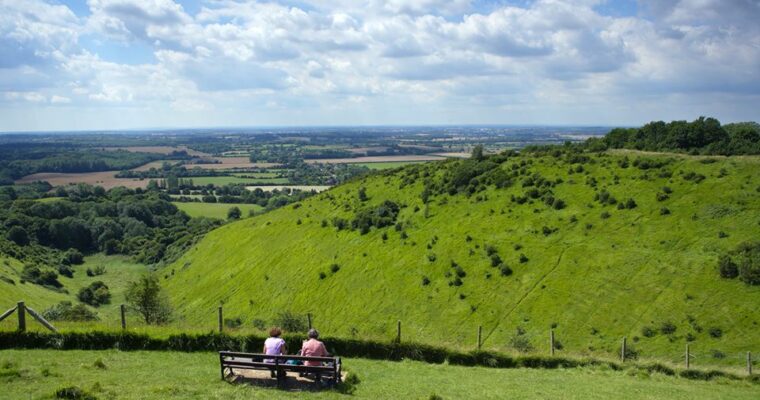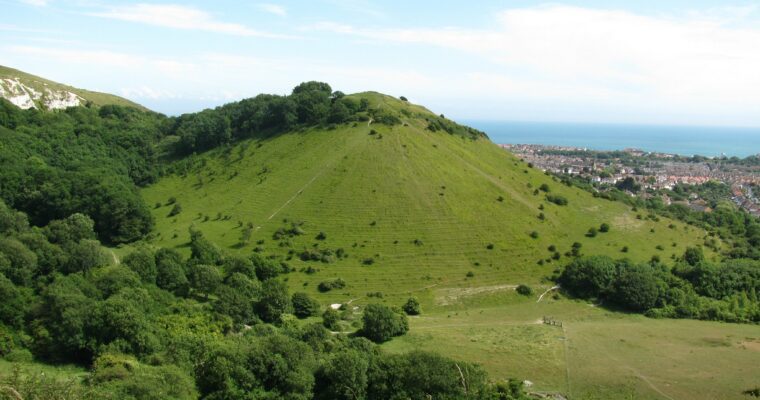Chalk Hill Figures in the Kent Downs
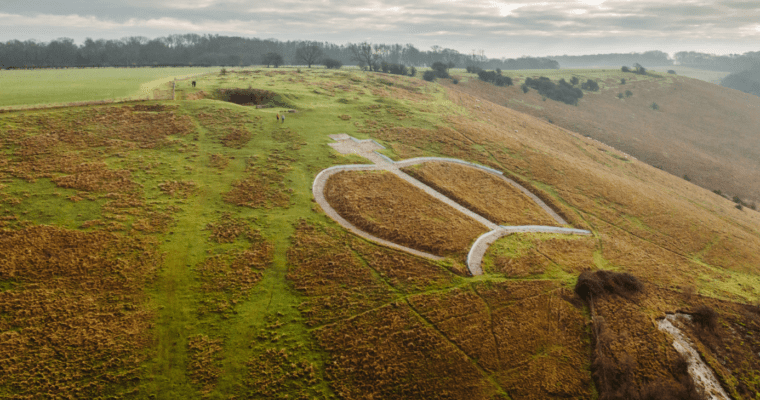
25th July 2022
What is a hill figure?
Hill figures, chalk landmarks or geoglyphs are large, visual representations that are cut into the side of steep hills, revealing the geology beneath. There are a variety of reasons for the creation of these landmarks. For example, many chalk hill figures have political significance, whilst others are commemorative.
There are over 50 hill figures in the UK. These are primarily cut into the abundant chalk downland of southern England. Most hill figures in the UK are white horses, but military badges, crosses and other animals are popular too. The oldest and most famous hill figure is the Uffington White Horse in Oxfordshire – it has now been dated at 3,000 years old!
Hill figures in the Kent Downs
There are four distinctive hill figures carved into the iconic chalk of the Kent Downs Area of Outstanding Natural Beauty:
Wye Memorial Crown
Wye’s iconic memorial crown was created to celebrate the coronation of King Edward VII in 1902, an idea conceived by the principal of Wye Agricultural College. On the night of the coronation, the crown was lit with bonfires. Two years later, the King stayed at Eastwell Manor in Ashford and was able to see the lit-up crown sculpture for himself. Similar to Shoreham and Lenham crosses, the Wye crown was hidden during World War II to prevent it from being used as a navigational landmark by enemy aircraft.
The 180-foot-tall sculpture is easily accessible on foot, sitting beneath the North Downs Way National Trail. Impressive views across Wye and beyond can be enjoyed from above the sculpture.
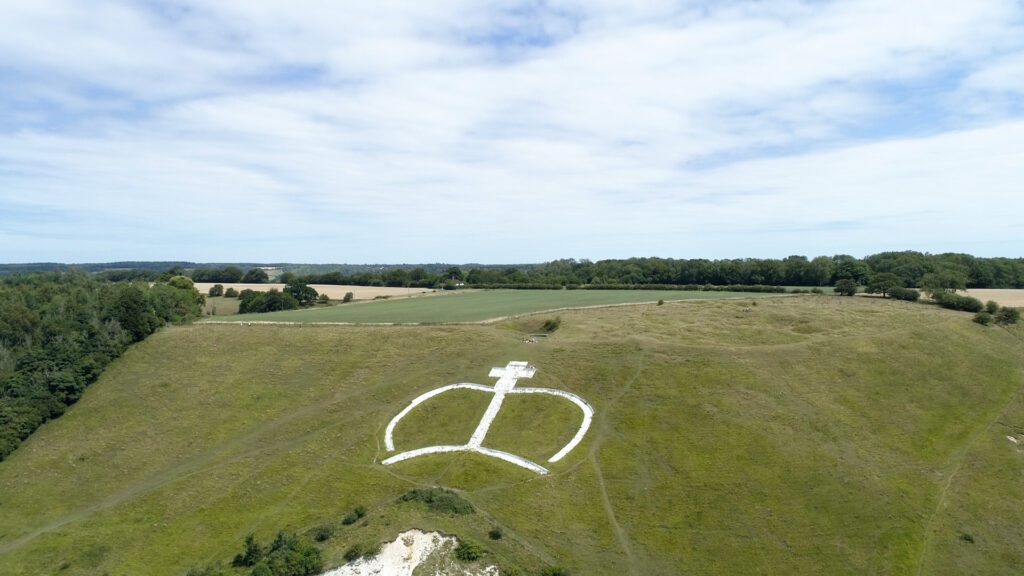
Shoreham Memorial Cross
Shoreham Memorial Cross is a Christian cross landmark sited to the west of Shoreham village. The project to carve the cross was championed by a local man named Samuel Cheeseman, after both of his sons were killed on active duty in World War I. He was determined to commemorate his sons and the other 48 men from Shoreham who were lost in the war.
The site was donated by local landowner and war veteran, Francis Mildmay, and the cross was completed in September 1921, after 16 months of work. As part of the annual remembrance Samuel Cheeseman would pull a small cannon up the hill to the cross.
Shoreham Memorial Cross can be viewed from the village, and a public footpath leads from the village up the hill to the cross.
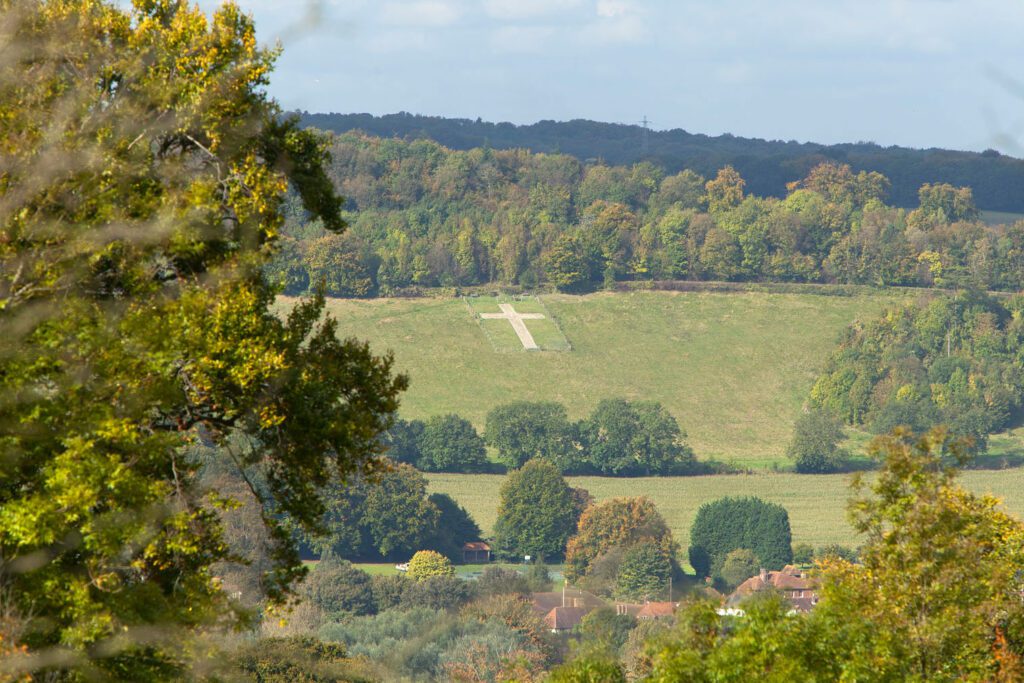
Lenham Memorial Cross
This memorial landmark commemorates the casualties of WWI and WWII, remembering the 56 men lost from the parish over the two wars. It was designed by Lenham school’s Headmaster, and was constructed above the village on the North Downs in 1922.
The cross was covered with earth during WWII, until unveiled again in 1945, and an annual memorial service was held at the site until 1960. In 1977, the dedicatory stones at the foot of the cross were moved to Lenham church to enable surviving relatives of those named on the stones to continue to visit. Historic England registered the cross as a National Monument and War Memorial in December 2017.
Views of the cross can be seen from the A20, and the site can be easily accessed from the North Downs Way trail below.
Folkestone White Horse
Finished in 2003, the Folkestone White Horse is the youngest hill figure in the UK. Situated on the North Downs overlooking the Channel Tunnel terminal, the hill figure was originally planned as a millennium landmark. In 1998, local artist Charlie Newington conceived the idea and designed the horse, inspired by the Uffington White Horse in Oxfordshire. However, the hill figure was the subject of much controversy and was opposed by environmentalists, as the site chosen was home to rare plant species. After a public enquiry, planning permission was granted in 2002, and work began on the sculpture. Chalk blocks were laid on the ground instead of cutting into the landscape. Gurkha soldiers spent seven days building the image, completing it in the summer of 2003. Later, in 2004, a time capsule was buried beneath the horse’s heart.
The white horse hill figure was dedicated to the people of Folkestone, and has become symbolic of the town. It even features in the logo for Folkestone and Hythe District Council.
The horse is on a steep slope, and the land is a SSSI (Site of Special Scientific Interest) and a SAC (Special Area of Conservation), so take care when visiting. Great views of the horse can be enjoyed from across Folkestone, including from the public footpath beneath the hill. Alternatively, the North Downs Way runs above the white horse, boasting panoramic views across Folkestone, the Strait of Dover and even to France on a clear day.

Where to explore
Popular articles
The Best Viewpoints in the Kent Downs
Searching for incredible views? Look no further! We've rounded up the best…
Top 5 bluebell walks in the Kent Downs
If you're looking for inspiration on the best places for some bluebell…
Lambing season in the Kent Downs
Discover the importance of lambing season in the Kent Downs and find…


